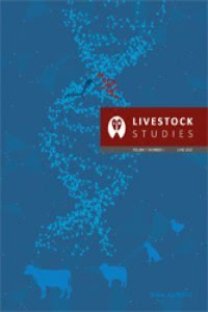Çevresel faktörler ve Büyüme Hormon Reseptörü genindeki polimorfizmin malaklarda büyüme eğrisi ve canlı ağırlık parametrelerine etkisi
Bu araştırma, malaklarda Brody büyüme eğrisi katsayılarına ve farklı canlı ağırlık parametrelerine çeşitli çevre faktörleri ve büyüme hormon reseptör (GHR) genindeki polimorfizmin etkilerini belirlemek amacıyla yapılmıştır. Araştırmanın materyalini Afyon Kocatepe Üniversitesi Hayvancılık Araştırma ve Uygulama Merkezinde yetiştirilmiş 2009 doğumlu 27 baş malağa ait kayıtlar ve kan örnekleri oluşturmuştur. Malaklarda eğri katsayıları A, B ve k ile doğum, 180. gün ve 360. gün canlı ağırlıkları sırasıyla 366.589±31.698, 0.932±0.011, 0.002±0.000, 30.696±1.043 kg, 121.701±5.071 kg ve 188.834±8.442 kg olmuştur. GHR geninin 10. ekzonunda G3676A, G3679A ve G3680del olmak üzere üç polimorfik bölge tespit edilmiştir. A katsayısı üzerine cinsiyetin ve 180. gün ağırlığı üzerine doğum ağırlığının etkisi önemli (P<0,05) bulunmuştur. Bulgular, G3676A ve G3679A pozisyonlardaki polimorfizm ile haplotiplerin önemli farklara yol açma eğiliminde olduğunu fakat eldeki verilerin bunu ortaya koymaya yetmediğini göstermiştir.
The effect of environmental factors and Growth Hormone Receptor gene polymorphism on growth curve and live weight parameters in buffalo calves
This study was conducted to determine the effects of some environmental factors and growth hormone receptor gene polymorphisms (GHR) on Brody growth curve coefficients and different body weights parameters in buffalo calves. The records and blood samples of 27 buffalo calves, born in 2009, bred at Afyon Kocatepe University Animal Research Center were analyzed. A, B and k parameters for the Brody model were estimated as 366.589±31.698, 0.932±0.011 and 0.002±0.000 respectively. In addition, live weights at birth, 180 and 360 days were 30.696±1.043 kgs, 121.701±5.071 kgs and 188.834±8.442 kgs respectively. Three polymorphic regions were detected at G3676A, G3679A and G3680del bases in exon 10 of the GHR gene. Effects of sex on parameter A and birth weight on weight at 180 days were statistically significant (P<0.05). Findings indicated that G3676A and G3679A mutations and haplotypes consisting of mentioned SNPs may result in significant differences in growth traits, but the available data were not enough to reveal this fact
Keywords:
Water buffalo, growth curve, growth hormone receptor, SNP,
- Yayın Aralığı: Yılda 2 Sayı
- Başlangıç: 1959
- Yayıncı: Sezer ÖZ
Sayıdaki Diğer Makaleler
Anadolu Mandalarında bazı morfometrik özellikler
İsmail KELGÖKMEN, Necmettin ÜNAL
Koray ÇELİKELOĞLU, Metin ERDOĞAN, Serdar KOÇAK, Fahriye ZEMHERİ, Mustafa TEKERLİ
Koray ÇELİKELOĞLU, Metin ERDOĞAN, Serdar KOÇAK, Fahriye ZEMHERİ, Mustafa TEKERLİ
Yurdakul SAÇLI, Zeki BAYRAMOĞLU
Yurdakul SAÇLI, Zeki BAYRAMOĞLU
Epigenetik ve genomik baskılanma
Ömer Faruk GÜNGÖR, Necmettin ÜNAL
Kurutulmuş damıtma-tane ve çözünürlerinin (DDGS) hayvan beslemede kullanımı
